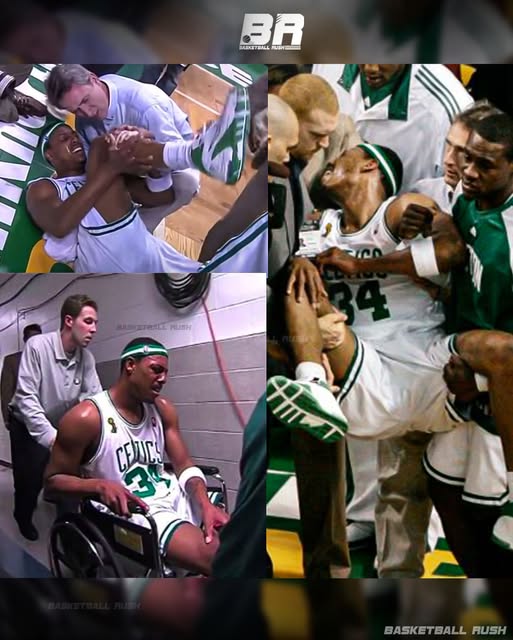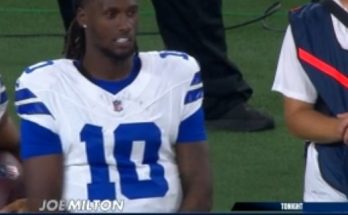One of the most heartbreaking moments in NBA history came in the 2008 NBA Finals when Boston Celtics star Paul Pierce went down in what appeared to be a devastating injury. The moment etched itself into the memory of basketball fans worldwide—not because of stats or box scores, but because of the raw, emotional weight it carried. It was the kind of moment that had the entire basketball universe holding its collective breath, a reminder that behind every championship dream lies the very real possibility of heartbreak.
It was Game 1 of the 2008 NBA Finals. The stage couldn’t have been bigger. The Boston Celtics were facing their historic rivals, the Los Angeles Lakers, renewing a storied rivalry that had defined generations. The atmosphere inside TD Garden was electric. Celtics fans had waited over two decades for this chance, and they were filled with hope, anticipation, and the weight of history. And leading the charge was their captain, Paul Pierce—nicknamed “The Truth”—who had endured the painful rebuilding years and now stood at the doorstep of greatness.
Midway through the third quarter, with the game hanging in the balance, the unthinkable happened. Pierce drove into the paint and got tangled up with teammate Kendrick Perkins and Lakers center Kobe Bryant. As he landed, his knee buckled awkwardly. He immediately collapsed to the hardwood in visible pain. The entire arena fell silent. Fans stared in disbelief. On the floor lay the heart and soul of the team. The Celtics’ championship hopes appeared to have taken a crushing blow.
Pierce grimaced, his face contorted in agony. Medical staff rushed to his side. The scene was surreal. Not long after, to the shock of everyone watching, a wheelchair was brought out. Pierce was lifted into it, his body language suggesting something serious had just occurred. As he was rolled off the court and into the tunnel, fans at TD Garden stood frozen. Tears welled up in some eyes. Others simply clutched their heads or covered their mouths. The feeling was universal: the Celtics’ dream run might have just ended right there.
It wasn’t just Celtics fans who felt it. NBA fans across the world, regardless of team affiliation, shared in the heartbreak. Paul Pierce was not just any player—he had fought and clawed his way through years of mediocrity with Boston. He stayed loyal when others would’ve left. He endured trade rumors, losing seasons, and organizational chaos. This Finals was supposed to be his moment. And now, just like that, it all seemed to be slipping away.
For the next several minutes, basketball seemed secondary. Commentators speculated endlessly about the injury. Was it a torn ACL? Would he miss the remainder of the series? Would this impact the rest of his career? Every question hung heavy in the air, without answers. Even the players on the floor looked shaken. Kevin Garnett and Ray Allen, who had joined Boston the previous summer to form a new “Big Three,” appeared visibly concerned. The entire Celtics bench seemed stunned, their leader taken from them in the most high-stakes moment imaginable.
And then, the unthinkable happened.
To roaring applause and stunned disbelief, Paul Pierce emerged from the tunnel—under his own power. The crowd erupted like a volcano. The same fans who moments earlier were mourning now leaped to their feet in jubilation. He wasn’t limping. He didn’t appear to be heavily bandaged. But his face told the story. Determination. Fire. Willpower. The Truth had returned.
What followed was the stuff of legend. Pierce re-entered the game, and just minutes after returning from what had looked like a season-ending injury, he buried back-to-back three-pointers. The Garden exploded. The momentum of the game shifted dramatically. The Celtics would go on to win Game 1, and eventually the series in six games, capturing their first NBA title since 1986. Pierce was named Finals MVP. It was the culmination of a journey defined by patience, perseverance, and pain.
But despite the triumph, that moment in the wheelchair remains seared into NBA history—not just because of its drama, but because of the emotional chaos it caused in real time. It was a rollercoaster that took fans from despair to ecstasy in the span of minutes. And in hindsight, it symbolizes something even greater: the fragility of greatness, and how quickly dreams can be threatened.
In the years that followed, the “Wheelchair Game” became one of the most talked-about incidents in NBA lore. Some fans questioned the legitimacy of the injury, poking fun at the dramatic nature of Pierce’s exit and re-entry. In fact, years later, Pierce would make a tongue-in-cheek confession that he “just had to go to the bathroom,” which only added to the mythos and memes surrounding the moment. But even if there was a sliver of exaggeration or gamesmanship, it didn’t erase the genuine fear and heartbreak that had swept over the basketball world when he first went down.
And that’s the heart of this story. Because whether you believe the injury was real, exaggerated, or somewhere in between, what it represented was real. The emotions were real. The heartbreak was real. It was a reminder of how quickly everything can change in sports. One wrong step, one bad fall, one twist of fate—and everything you’ve worked for can vanish. It’s the reason fans get so invested, and the reason athletes pour their souls into the game.
For Paul Pierce, that Finals performance cemented his legacy. No longer was he just a prolific scorer or a Boston favorite—he became a legend. A champion. A warrior. And while lifting the trophy was the fairy-tale ending, the moment that fans will never forget is when he was wheeled off the court. It was the lowest of lows, and yet, it made the eventual high feel that much higher.
It was a microcosm of life itself. Pain, fear, uncertainty… followed by courage, resilience, and triumph. And that’s why, even more than a decade later, Paul Pierce’s injury in the 2008 NBA Finals still stands as one of the most heartbreaking—and eventually inspiring—moments in basketball history.
To this day, fans remember where they were when it happened. They remember the gasp, the silence, the tension. And they remember the roar when he came back. Because in those few minutes, the game became more than just basketball. It became a story of human emotion—unfiltered and unforgettable. Whether you loved or hated the Celtics, that moment united fans in a shared experience, a communal heartbreak, and a collective sigh of relief. And that’s what makes it iconic.
In the world of sports, legends aren’t just born from stats and banners. They’re born from moments—moments that pierce the soul and etch themselves into the heart of the game. Paul Pierce’s injury in Game 1 of the 2008 Finals was one of those moments. A heartbreaking chapter that made the ending even sweeter. A sudden fall that made the rise unforgettable. A scene that every true basketball fan will never forget.



